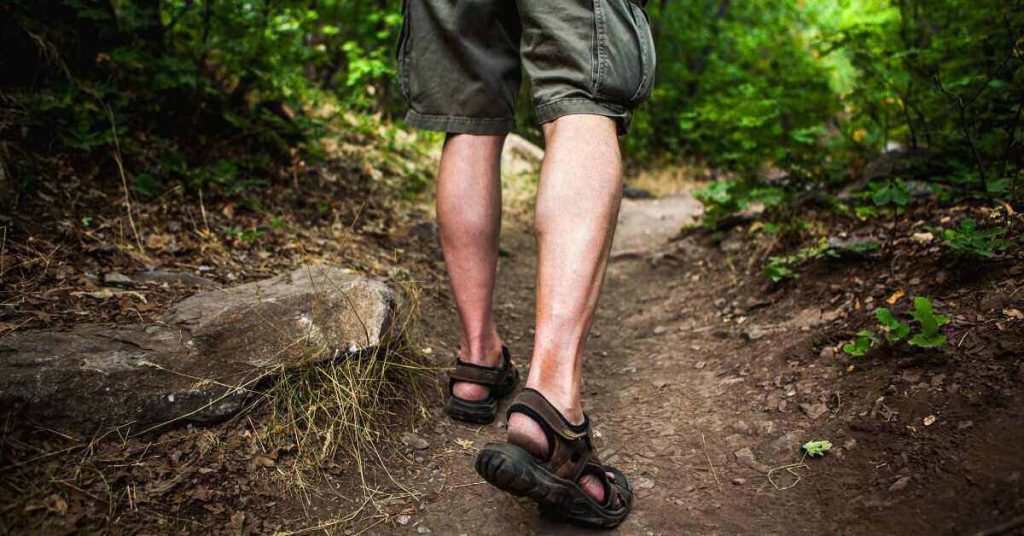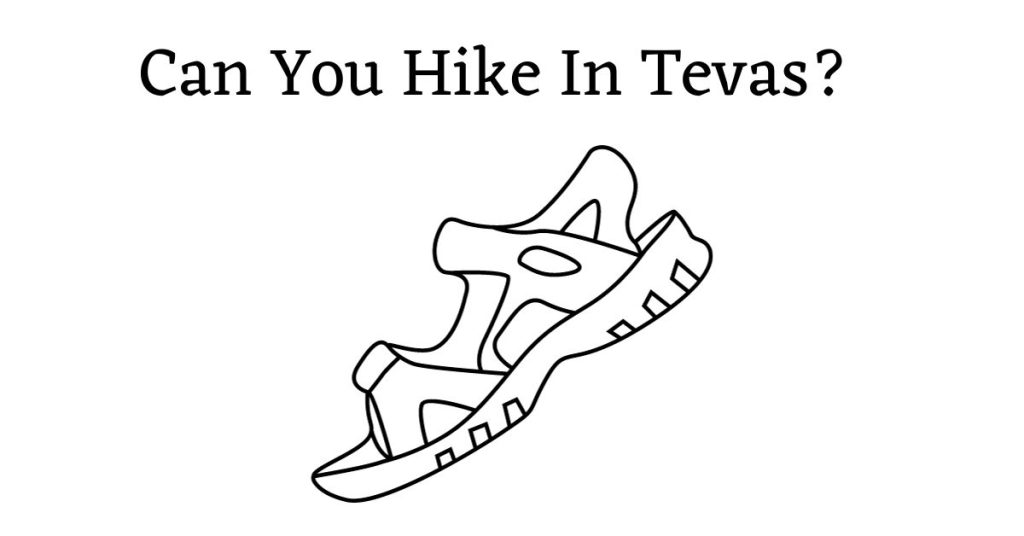If you’re an adventure seeker who values comfort and versatility, you’ve probably pondered this question before. Tevas, with their signature strappy design and water-friendly features, have long been a favorite for casual summer strolls and beach days.
But are Tevas good for hiking? Tevas are versatile outdoor sandals, but they may not be the best option for intense hiking. While they provide decent traction and breathability, they lack ankle support and protection, making them more suitable for casual walks or water activities rather than rigorous hikes.
The Pros of Hiking in Tevas
Here are the pros of choosing Tevas for your hiking excursions:
- Comfort and Breathability: Tevas are designed for comfort, with open-toe construction and adjustable straps that provide a customizable fit. This design allows your feet to breathe, keeping them cool and comfortable on hot days.
- Lightweight: They are incredibly lightweight, ensuring you can hike for extended periods without feeling weighed down or fatigued. This lightweight design enhances your agility and freedom of movement on the trails.
- Quick-Drying: They’re equipped with quick-drying materials that wick away moisture. This feature keeps your feet dry, preventing discomfort and blisters caused by sweaty feet, even during strenuous hikes.
- Cushioned Footbed: Tevas come with a cushioned footbed that offers superior shock absorption. This cushioning reduces the risk of foot fatigue and discomfort, allowing you to hike for longer distances without pain.
The Cons of Hiking in Tevas
Hiking in Tevas, while appealing for their comfort and freedom, has drawbacks, particularly regarding safety and support. Here are the cons of hiking in Tevas:
- Lack of Ankle Support: Tevas, with their open design and minimalistic construction, lack the ankle support hiking boots provide. On challenging terrains with uneven surfaces, this lack of support can increase the risk of ankle twists, sprains, or other injuries.
- Limited Foot Protection: Tevas offer minimal protection for your feet, exposing them to potential hazards on the trail. Sharp rocks, thorns, and other debris can easily penetrate the open design of the sandals, leading to discomfort or injuries.
- Inadequate Traction: While Tevas have a rubber outsole, it may not provide the same level of traction as hiking boots designed for rugged terrain. Slippery or unstable surfaces can pose a safety hazard, as Tevas may not offer the same grip and stability.
- Reduced Durability: The materials used in Tevas may not be as durable as those in hiking boots. Continuous exposure to rough terrain and challenging conditions can lead to quicker wear and tear, potentially necessitating more frequent replacements.
- Limited Versatility: Tevas are best suited for well-maintained and easy trails. They may not provide the versatility and protection required for more challenging hikes, where rugged terrain and adverse weather conditions are common.
For more challenging hikes involving steep inclines, rocky paths, or unpredictable surfaces, invest in hiking boots with ankle support and enhanced protection.
How to Properly Fit Tevas for Hiking
To ensure a proper fit for hiking, it’s important to measure your foot and refer to Teva’s sizing chart. Start by placing your foot on a piece of paper and tracing around it. Measure the length from the heel to the tip of the longest toe and the width at the widest part.
Once you have these measurements, compare them to Teva’s sizing chart to determine your size. Remember, getting the right fit is crucial for comfort and performance on the trails.

When trying on Tevas, wear the socks you plan to hike in. This will give you a more accurate feel for how the sandals will fit during your outdoor adventures. Walk around in them and pay attention to any pressure points or areas of discomfort. Your foot should feel secure and supported, with enough room for your toes to wiggle.
Keep in mind that Tevas are known for their adjustable straps, allowing you to customize the fit to your liking. Experiment with different strap configurations to find the perfect balance of freedom and support. Don’t be afraid to make adjustments until you achieve the liberation your feet desire.
Techniques for Hiking in Tevas on Different Terrain
When hiking in Tevas on different terrains, it’s important to adjust your stride and foot placement to maintain stability and prevent slipping.
On rocky trails, plant your feet firmly and use a shorter stride to keep your balance. Your Tevas provide great traction, but still, be cautious of loose rocks.
When tackling steep inclines, take smaller steps and distribute your weight evenly to avoid any potential slips. Tevas are designed to handle wet conditions, so when crossing streams or walking on muddy paths, trust your sandals’ grip. Just remember to step carefully and avoid any deep puddles that could cause discomfort.
When walking on sandy or sandy-like terrains, allow your feet to sink slightly into the sand, providing a natural grip and stability. Embrace the sensation of the warm sand beneath your toes as you walk freely along the beach or desert trails.
Always listen to your body and adjust your stride accordingly to maintain a comfortable hiking experience in your Tevas.
Maintaining and Caring for Your Tevas After Hiking
After a long hike in your Tevas, take a moment to clean off any dirt or debris from your sandals to ensure they stay in good condition.
Here are five ways to maintain and care for your Tevas after a long hike:
– Rinse them off with water: Gently wash away any dirt or mud from your Tevas using water. This will help prevent any stains or build-up that can damage the material.
– Air dry them: Allow your Tevas to dry naturally in the open air. Avoid using direct heat sources like hairdryers or heaters, as they can cause the material to warp or shrink.

– Treat them with a waterproof spray: Protect your Tevas from water damage by applying a waterproof spray. This will help keep them in good condition and extend their lifespan.
– Store them properly: When not in use, store your Tevas in a cool and dry place. Avoid leaving them in direct sunlight, as it can cause the colors to fade and the material to deteriorate.
– Check and replace worn-out parts: Regularly inspect your Tevas for any worn-out straps or soles. If necessary, replace them to ensure optimal performance and comfort.
Chacos vs Tevas for Hiking – Which is Better?
When it comes to choosing the right footwear for hiking, the debate between Chacos and Tevas has been ongoing among outdoor enthusiasts. Both brands offer durable and comfortable sandals designed to tackle various terrains, but which one is better suited for your hiking adventures?
Chacos are renowned for their robust and supportive design. They come with a contoured footbed and adjustable straps that provide excellent arch support and stability.
This makes them a preferred choice for hikers who tackle rough and uneven terrain. The Vibram outsoles offer superb traction, ensuring you stay surefooted on rocky paths and river crossings. Chacos are also known for their durability, capable of handling years of outdoor abuse.
Tevas, on the other hand, are known for their versatility and lightweight construction. They are perfect for less strenuous hikes, especially in warm weather. Tevas offer comfort and breathability with their open-toe design, making them an excellent choice for casual or leisurely hikes.
They might not have the same level of arch support as Chacos, but they excel in allowing your feet to breathe and stay cool on hot summer trails.
So, which is better? It ultimately depends on your hiking preferences and the type of trails you plan to conquer.
If you’re tackling rugged terrain with challenging elevation changes, Chacos might be your go-to choice for their robust support and stability. However, if you prefer a more lightweight and breathable option for less demanding hikes, Tevas could be the better fit.
In the end, both Chacos and Tevas have their strengths and are trusted by outdoor enthusiasts worldwide. The best choice comes down to your individual needs and the specific demands of your hiking adventures. Whichever you opt for, break them in before embarking on a lengthy hike to ensure maximum comfort on the trail.
Final Thoughts
Hiking in Tevas can be a great option for those seeking comfortable and versatile footwear. While they may not be suitable for all terrains, Tevas excel in providing breathability and flexibility.
Related

